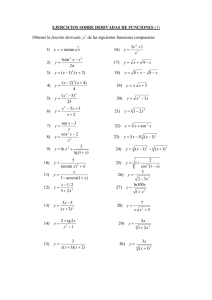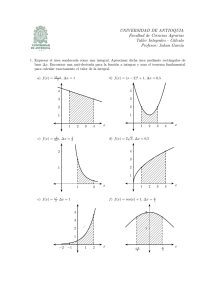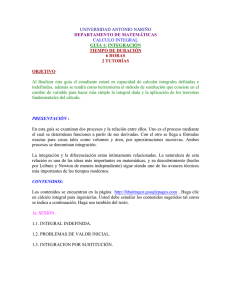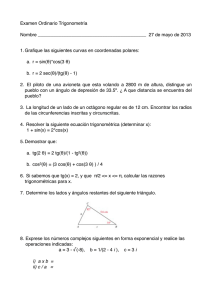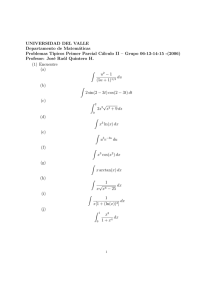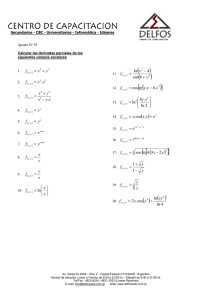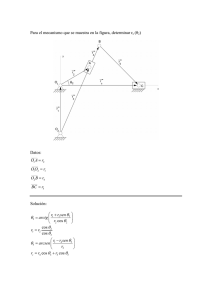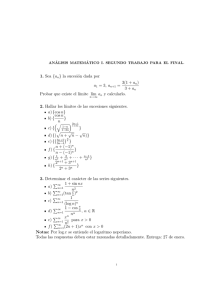Sustitución simple o cambio de variable
Anuncio
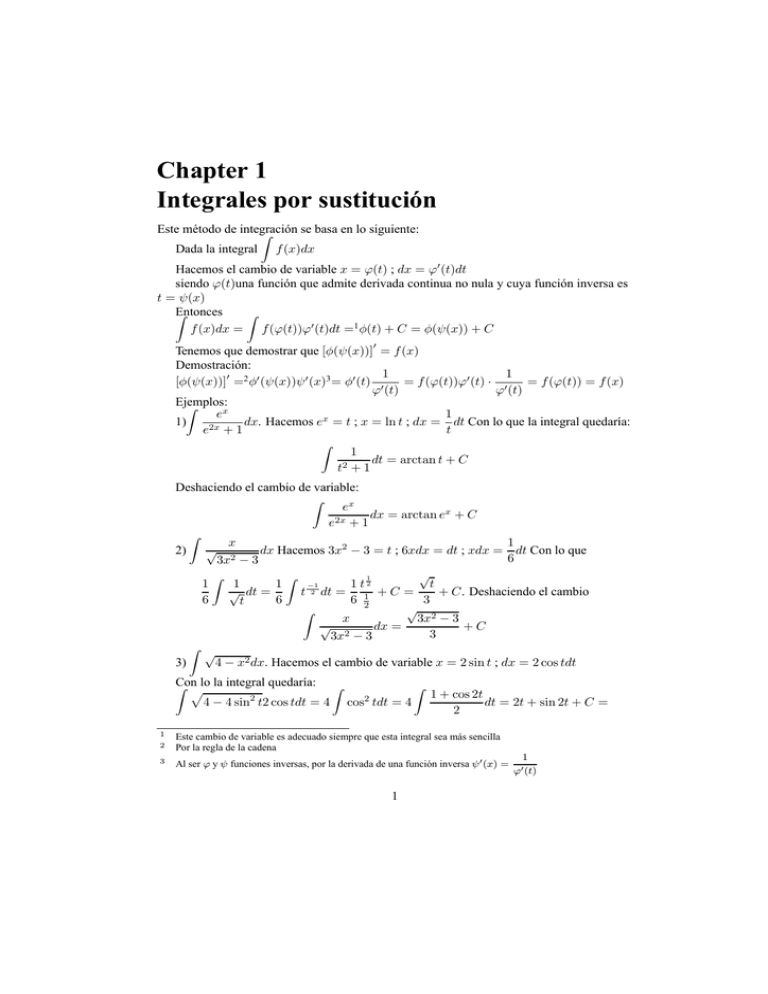
Chapter 1 Integrales por sustitución Este método de integración se basa en lo siguiente: Z Dada la integral f (x)dx Hacemos el cambio de variable x = ϕ(t) ; dx = ϕ0 (t)dt siendo ϕ(t)una función que admite derivada continua no nula y cuya función inversa es t = ψ(x) Entonces Z Z f (x)dx = f (ϕ(t))ϕ0 (t)dt =1 φ(t) + C = φ(ψ(x)) + C Tenemos que demostrar que [φ(ψ(x))]0 = f (x) Demostración: 1 1 0 = f (ϕ(t))ϕ0 (t) · 0 = f (ϕ(t)) = f (x) [φ(ψ(x))] =2 φ0 (ψ(x))ψ 0 (x)3 = φ0 (t) 0 ϕ (t) ϕ (t) Ejemplos: Z 1 ex 1) dx. Hacemos ex = t ; x = ln t ; dx = dt Con lo que la integral quedaría: e2x + 1 t Z 1 dt = arctan t + C t2 + 1 Deshaciendo el cambio de variable: Z ex dx = arctan ex + C 2x e +1 Z x 1 √ dx Hacemos 3x2 − 3 = t ; 6xdx = dt ; xdx = dt Con lo que 2) 2 6 3x − 3 √ Z Z 1 1 t2 1 −1 t 1 1 √ dt = t 2 dt = 1 + C = + C. Deshaciendo el cambio 6 6 6 3 t 2 √ Z 3x2 − 3 x √ dx = +C 2 3 3x − 3 Z √ 4 − x2 dx. Hacemos el cambio de variable x = 2 sin t ; dx = 2 cos tdt 3) Con Z Z plo la integral quedaría: Z 1 + cos 2t 4 − 4 sin2 t2 cos tdt = 4 cos2 tdt = 4 dt = 2t + sin 2t + C = 2 1 2 3 Este cambio de variable es adecuado siempre que esta integral sea más sencilla Por la regla de la cadena Al ser ϕ y ψ funciones inversas, por la derivada de una función inversa ψ 0 (x) = 1 1 ϕ0 (t) Chapter 1 Integrales por sustitución = 2t + 2 sin t cos t + C √ x x 4 − x2 Deshaciendo el cambio de variable ( t = arcsin ; sin t = ; cos t = ) 2 2 2 √ Z √ x x 4 − x2 2 4 − x dxdx = 2 arcsin + +C 2 2 Z √ 4) cos xdx4 Realiza el cambio de variable siguiente x = t2 ; dx = 2tdt Z Tendrás que resolver por partes la siguiente integral 2 t cos tdt y después volver a deshacer el cambio de variable. Z t cos tdt = cos t + t sin t + C Por Z lo tanto √ √ √ √ cos xdx = 2 (cos x + x sin x) + C 1.1 Ejercicios de integración por cambio de variable Z 1 dx + 2−x Realizamos el siguiente cambio de variable 1 1 1 · ln t → dx = · dt 2x = t → x ln 2 = ln t; x = ln 2 ln 2 t Con lo que la integral quedará de la siguiente manera: Z Z 1 1 1 1 arctan t I1 =5 dt = · dt = +C 2 1 ln 2 t ln 2 (t + 1) ln 2 t+ t Deshaciendo el cambio de variable tendremos Z 1 1 dx = arctan 2x + C ln 2 2x + 2−x – I1 = 2x Nota:Esta integral;Ztambién se puede Zresolver con las siguientes transformaciones Z Z 1 1 2x 2x dx = dx = dx = dx = 2 1 2x + 2−x 22x + 1 1 + (2x ) 2x + x 2 4 5 Z Z √ √ cos x x √ dx x √ √ cos x Intégrala por partes considerando f (x) = x y g 0 (x) = √ x 1 2−x = 2x Otra forma de resolverla:→ cos √ xdx = 2 Section 1.1 1 ln 2 Z 2x · ln 2 1+ 2) I2 = (2x )2 Z dx = Ejercicios de integración por cambio de variable 1 arctan 2x + C ln 2 e2x + ex dx ex − 1 Realizamos el siguiente cambio de variable ex = t → x ln e = ln t; x = ln t → dx = 1 dt t Con lo que la integral quedará de la siguiente manera: Z 2x Z 2 Z 2 Z e + ex t +t t +t 1 t+1 dx = · dt = dt dt = x 2 e −1 t−1 t t−1 t −t Como t+1 2 =1+ ; entonces t−1 t−1 ¶ Z µ Z t+1 2 dt = 1+ dt = t + 2 ln |t − 1| + C t−1 t−1 Deshaciendo el cambio de variable Z 2x e + ex dx = ex + 2 ln |ex − 1| + C ex − 1 Nota:Esta integral; también se puede resolver con la siguiente idea feliz: ¶ Z µ Z 2x Z (ex )2 + ex e + ex 2 · ex 6 x e + x dx = dx = dx = ex + 2 ln |ex − 1| + C ex − 1 ex − 1 e −1 Z ex + 1 3) I3= dx ex + 2 + e−x Realizamos el siguiente cambio de variable ex = t → x ln e = ln t; x = ln t → dx = 1 dt t Con loZque la integral quedaráZde la siguiente manera: Z Z t+1 t+1 t+1 1 1 dt = dt = I3 = dt = · dt = 2 2 1 t t+1 t + 2t + 1 (t + 1) t+2+ t ln |t + 1| + C Deshaciendo el cambio de variable Z ex + 1 dx = ln |ex + 1| + C ex + 2 + e−x 6 (ex )2 + ex ex −1 = ex + 2 · ex ex − 1 3 Chapter 1 Integrales por sustitución Nota:Otra forma de resolverla; sería Z Z Z ex + 1 ex + 1 e2x + ex dx = dx = dx = 1 ex + 2 + e−x e2x + 2ex + 1 x e +2+ x e Z Z x x x e (e + 1) e x dx = dx = ln |e + 1| + C 2 ex + 1 (ex + 1)Z 1 4) I4= dx x(1 + ln x) Realizamos el siguiente cambio de variable ln x = t → x = et ; → dx = et dt Con loZ que la integral quedará Z de la siguiente manera: 1 1 · et dt = I4 = dt = ln |t + 1| + C t t + 1 e (1 + t) Deshaciendo el cambio de variable Z 1 dx = ln |1 + ln x| + C x(1 + ln x) Nota:Otra forma de resolverla; sería 1 Z Z 1 x dx = dx = ln |1 + ln x| + C x(1 +Z ln x) (1 + ln x) 1 + ln x dx 5) I5= x(1 − ln x) Realizamos el siguiente cambio de variable ln x = t → x = et ; → dx = et dt Con loZ que la integral quedará ¶ Z de la siguiente Z µmanera: 1+t t+1 2 t I5 = · e dt = dt = −1 − dt = −t − 2 ln |t − 1| + C 1−t t−1 et (1 − t) Deshaciendo el cambio de variable Z 1 + ln x dx = − ln |x| − 2 ln |1 − ln x| + C x(1 − ln x) √ Z 2+ 6x−1 dxdx 6) p √ 3 (x − 1)2 − x − 1 Realizamos el siguiente cambio de variable x − 1 = t6 (fíjate que 6 = m.cm(2, 3, 6))→ x = t6 + 1 → dx = 6t5 dt Con lo que √ Z Z 6 2 + t6 6t3 + 12t2 5 · 6t dt = dt = √ √ 3 12 t−1 t − t6 4 Section 1.1 Ejercicios de integración por cambio de variable ¶ Z µ 18 dt = 2t3 + 9t2 + 18t + 18 ln |t − 1| + C 6t2 + 18t + 18 + t−1 Deshaciendo el cambio de variable √ Z ¯√ ¯ √ √ √ 2+ 6x−1 dx = 2 x − 1 + 9 3 x − 1 + 18 6 x − 1 + 18 ln ¯ 6 x − 1 − 1¯ + C p √ 3 (x − 1)2 − x − 1 Z 1 7) dx √ √ 4 x − x3 Realizamos el siguiente cambio de variable x = t4 (fíjate que 4 =Z m.c.m(2, 4))→ dx = 4t3 dt Z 1 1 dx = · 4t3 dt = √ √ √ √ 4 4 12 3 4 x− xZ µ t −¶ t Z t 1 4 dt = 4 −1 + dt = 4 (−t − ln |1 − t|) + C 1−t 1−t Deshaciendo el cambio de variable Z √ √ 1 dx = 4 (− 4 x − ln |1 − 4 x|) + C √ √ 4 x− √ x3 Z x− x−1 dx 8) √ x+ x−1 Realizamos el siguiente cambio de variable x − 1 = t2 → x = t2 + 1 → dx = 2tdt Con lo que √ Z Z 2 Z 3 x− x−1 t +1−t t − t2 + t dx = · 2tdt = 2 dt √ t2 + 1 + t t2 + t + 1 x+ x−1 Esta integral es racional; sigue resolviéndola tú Z ¡t3 − t2 + t¢ ¡ ¢ El resultado de dt ha de ser: 12 t2 − 2t + ln t2 + t + 1 + 2 t +t+1 √ 2 2t+1 √ + C 3 3 arctan 3 5 Chapter 1 9) Z Integrales por sustitución dx √ (2 − x) 1 − x Realizamos el siguiente cambio de variable 1 − x = t2 → x = 1 − t2 → dx = −2tdt Con lo que Z Z Z −2tdt dt dx = = −2 = −2 arctan t + C √ 2 1 + t2 (2 − 1 + t )t (2 − x) 1 − x Deshaciendo el cambio de variable Z √ dx = −2 arctan 1 − x + C √ (2Z − x) 1 − x dx 10) √ x x+2 Realizamos el siguiente cambio de variable x + 2 = t2 → x = t2 − 2 → dx = 2tdt Con lo que ÃZ ! Z Z Z 2tdt dt dt dt 7 1 = =2 = √ √ − √ (t2 − 2) t (t2 − 2) 2 t− 2 t+ 2 ¯ √ ¯ √ ¯¢ 1 ¡ ¯ = √ ln ¯t − 2¯ − ln ¯t + 2¯ + C 2 Deshaciendo el cambio de variable Z ¯√ √ ¯ √ ¯¢ dx 1 ¡ ¯√ = √ ln ¯ x + 2 − 2¯ − ln ¯ x + 2 + 2¯ + C √ x x + Z2 2 x 11) I11 = √ dx 1+ x Realizamos el siguiente cambio de variable x = t2 →→ dx = 2tdt Con ¶ Z lo 2que Z Z µ t t3 1 2 · 2tdt = 2 − t + 1 − dt = 2 t dt = √ t+1 t+1 1µ+ t2 ¶ t3 t2 − + t − ln |t + 1| + C =2 3 2 Deshaciendo à √ el cambio de variable ! √ x3 x √ I11 = 2 − + x − ln | x + 1| + C 3 2 Z 1 √ 12) dx (x − 3)2 x2 − 2x + 5 7 ³ 1 1 = √ √ ´³ √ ´ 2 2 t− 2 t+ 2 à 1 1 √ − √ t− 2 t+ 2 6 ! Section 1.1 Ejercicios de integración por cambio de variable 1 Realizamos el siguiente cambio de variable x − 3 = t 1 −1 x = 3 + ; dx = 2 dt Con lo que la integral quedará así: t t Z Z 1 1 −1 √ sµ dx = dt µ ¶ ¶ 2 2 2 t2 (x − 3) x − 2x + 5 1 1 1 −2 3+ 3+ +5 t2 t t Z Z 16t + 4 − 4 1 t dt = − dt =− √ √ 2 16 8t + 4t + 1 8t2 + 4t + 1 Esta integral de dos integrales Z se descompone como suma Z 16t + 4 1 4 1 =− dt + dt = √ √ 2 2 16 16 8t + 4t + 1 8t + 4t + 1 2√ 2 1 =− 8t + 4t + 1 + J 16 4 Calculemos pues J por el método de los cuatro pasos Z 1 dt J= √ 8t2 + 4t + 1 √ √ Multiplicamos y dividimos por 4a( 32) Z √ 1 dt = J = 32 √ 256t2 + 128t + 32 2 Sumemos Z y restemos en el denominador b (16) √ 1 dt = 32 √ 256t2 + 128t + 16 − 16 + 32 Fíjate enZ esta transformación √ 1 dt : = 32 q 2 (16t + 4) + 16 Sacamos Z en el radicando del denominador factor Z común 16 √ √ 1 1 = 32 v dt = 2 s dt = ! µ ¶2 u à 2 u 16t + 4 (16t + 4) t16 +1 +1 4 16 Z √ 1 dt = 2 q 2 (4t + 1) + 1 Multiplicamos dentro de la integral por 4 y fuera de la integral dividimos por 4 para que no varíe √ Z √ ¯ ¯ q ¯ 2 2 ¯¯ 4 2 = ln ¯4t + 1 + (4t + 1) + 1¯¯ + C dt = q 4 4 (4t + 1)2 + 1 Z t dt dará Con lo que la integral K = − √ 8t2 + 4t + 1 7 Chapter 1 Integrales por sustitución √ ¯ ¯ q ¯ 2 ¯¯ 2√ 2 2 8t + 4t + 1+ ln ¯4t + 1 + (4t + 1) + 1¯¯ K=− 16 16 1 Deshaciendo el cambio de variable inicial y teniendo presente que t = tendremos x−3 que ¯ ¯ sµ s ¯ ¯ ¶2 ¯ ¯ 1 4 4 4 8 I12 = − + + 1+ ln ¯¯ +1+ + 1 + 1¯¯ + C = 8 (x − 3)2 x − 3 x−3 ¯ ¯x − 3 ¯ ¯ √ √ √ p 2 ¯¯ 1 + x + 2 (5 − 2x + x2 ) ¯¯ − x2 − 2x + 5 + ln ¯ I12 = ¯+C ¯ x−3 8 16 ¯ Z 1 1 √ dx ; x − 2 = 13) 2 2 t Z (x − 2) x − 4x + 1 1 1 p dy;; y = 14) 2+y+1 t y y Z 1 √ 14) dx x2 x2 − 4 −1 1 x = → dx = dt t t2 −1 Z Z Z p 2 1 −t √ rt √ dt = dt = 14 (1 − 4t2 ) + C dx = 1 1 x2 x2 − 4 1 − 4t2 −4 2 2 t t Deshaciendo el cambiosde variable; tendremos p µ ¶ Z (x2 − 4) 4 1 1 √ dx = 4 1− +C = +C 4x x2 x2 − 4 x2 Nota:Todas las integrales inmediatas también se pueden resolver por cambio de variable 8
